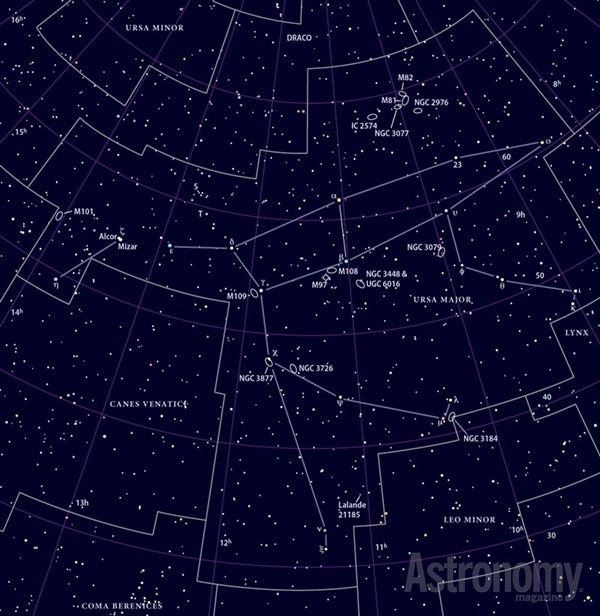Targets for March 5–12, 2015
Small telescope: Open cluster NGC 3532
Large telescope: Spiral galaxy M106
Large telescope: Spiral galaxy M109
This week’s small-telescope target is the Firefly Party Cluster, also known as NGC 3532, the Pincushion Cluster, and Caldwell 91. It’s an open cluster that lies in the constellation Carina the Keel.
This fabulous object sits in a terrific star field 4.7° south-southwest of magnitude 3.9 Pi (π) Centauri. You’ll spot the magnitude 3.0 object immediately with your naked eyes, but the impression will be of a bright glow within the Milky Way; the individual stars it contains are too faint to see.
It’s also big. NGC 3532 measures 55′ across. That means it covers an area more than three times as large as the Full Moon.
A 4-inch telescope at 100x displays more than 100 stars. Use a larger aperture and higher magnification and you’ll quickly get lost in this cluster. With an eyepiece that gives a wide field of view, you’ll notice numerous dark lanes dividing lines made of dozens of stars.
If you expand your view past the cluster’s tightly packed core, you’ll spot many colorful stars. Two sit at the cluster’s northeast end. Magnitude 6.9 SAO 238839 shines blue, while magnitude 6.2 SAO 238855 glows a deep red.
Even after I first observed NGC 3532 in 1986, I thought the deep-sky object with the best name was Thor’s Helmet. Now, I’m not so sure. It’s hard to top a star cluster that got one of its common names because it resembled a large number of fireflies throwing a party.
Don’t ignore this galaxy
This week’s first large-telescope object is spiral galaxy M106 in Canes Venatici the Hunting Dogs. It shines at magnitude 8.4 and measures 20.0′ by 8.4′.
One of the best and brightest galaxies on Charles Messier’s or any other list also ranks as one of the least observed.
It may be that because M106 falls near the end of Messier’s list, observers think it’s not a worthy target. Perhaps because it doesn’t have a catchy name like the Sombrero Galaxy (M104), it seems less appealing. Nothing could be further from the truth.
M106 lies in the northwest corner of Canes Venatici, and it makes a triangle with magnitude 3.7 Chi (χ) Ursae Majoris and magnitude 2.4 Phecda (Gamma [γ] Ursae Majoris). It lies 5.5° east of Chi and 7.5° southeast of Gamma. First impressions are of a bright core surrounded by an oval haze. Surrounding the nucleus is a stretched-out inner disk a third of the galaxy’s size.
M106’s equatorial plane tilts to our line of sight, as does that of the Andromeda Galaxy (M31), so many of M106’s features resemble those seen in the better known galaxy. This orientation may explain why M106’s dust lanes appear so prominent.
Through a 10-inch or larger telescope, you’ll begin to see its mottled texture and spiral structure. The strikingly linear northern arm appears more pronounced, while the southern arm looks more diffuse. Be patient when observing the southern arm, and wait for moments of good seeing to help you pull out detail.
The end of Messier’s line
This week’s second large-scope target is barred spiral galaxy M109 in Ursa Major the Great Bear. This is the final object on Messier’s list.
If you’re star-hopping to M109, first center magnitude 2.4 Phecda (Gamma [γ] Ursae Majoris) in your telescope. From Phecda, move 0.6° to the east-southeast.
You’ll have no trouble finding the galaxy from a dark site. It shines at magnitude 9.8 and measures 7.6′ by 4.3′.
Because of its size, M109 has a rather low surface brightness, but it’s still a great example of a barred spiral galaxy.
A telescope as small as 8 inches under superb sky conditions will reveal the bar. Be sure to use a magnification of 200x or above.
The bar extends from either side of a bright, non-stellar nucleus. The bar has a width of about 1′.
Expand your observing at Astronomy.com
StarDome
Check out Astronomy.com’s interactive StarDome to see an accurate map of your sky. This tool will help you locate this week’s targets.
The Sky this Week
Get a daily digest of celestial events coming soon to a sky near you.
Observing Talk
After you listen to the podcast and try to find the objects, be sure to share your observing experience with us by leaving a comment at the blog or in the Reader Forums.











